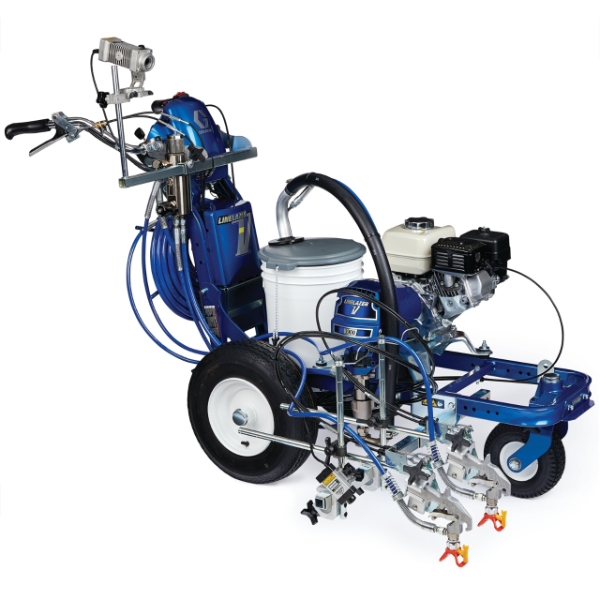Understanding Traffic Marking Materials
Successful traffic marking applications depend on experience, expertise, proper equipment and the right materials if they are to be effective and meet performance requirements. Selecting the appropriate material for a specific application is often the most challenging aspect of these jobs as weather factors and budget tolerances make decisions difficult.
For traffic marking applications, the materials most often used include:
- Paints (single and plural component)
- Thermoplastics
- Preformed Thermoplastics
- Traffic Tape
To help make purchasing decisions easier, let’s go through a high-level overview of each traffic marking material option.
Single Component Paint
Single component traffic marking paints include waterborne and oil-based options with both typically applied at a 15 mil thickness on roads and 6-10 mil thickness on parking lots for optimal performance. Waterborne materials are more environmentally-friendly and used more often to address increased regulatory mandates. Due to the demand and environmental concerns, these materials are often slightly more expensive than oil-based traffic marking paints.
Solvent-based traffic marking paints (also referred to as oil-based traffic marking paints) are more resilient and can be applied in more challenging weather conditions, specifically in colder and wetter environments, so they are typically used more in northern or predominantly wet climates.
Plural Component Paint
Plural component traffic marking materials are more prevalent in high-traffic areas such as roadways, crosswalks, bike paths and bus lanes as they provide an increased level of durability that exceeds single-component traffic marking paints. With up to 5X the life that allows for longer periods between traffic marking applications, municipalities and other organizations are able to maximize efficiencies with their material spend. Northern states typically use plural component materials more due to their increased durability and tolerance in cold weather climates.
Some of the most durable and increasingly popular dual component materials used in traffic marking applications are MMA (Methyl Methacrylate) & Epoxies. These materials can last up to 5 years and perform extremely well in hot or cold climates as well as high-traffic areas that require higher versatility and visibility such as bike or bus lanes. Since these coatings can be applied thicker, they are also optimal for including grit to provide anti-skid characteristics – making them popular for crosswalks and other pedestrian traffic areas. Applications are typically at a 25 mil thickness and adhere well to either asphalt or concrete.
Since these materials involve mixing two materials, a resin and hardener, these applications present more challenges for operators while requiring more advanced application equipment that not only mixes the material being applied but also tracks the pot life to prevent the material from curing in the pumping system, hose or gun. There is typically a very short pot-life, often just minutes. Along with mindful monitoring of cure timing, equipment such as the Graco Air-Purge Fusion gun can prevent material from hardening in the gun so operators can avoid unnecessary stoppages.
There are additional weather-related challenges as dual component pot-life can also vary by the temperature and humidity. Epoxies also present more complexity and higher equipment costs as they often require a heated system.
Thermoplastic
Thermoplastic is another highly-durable, cost-effective material that’s popular for heavy-traffic applications such as roads, highways and intersections. Thermoplastic consists of a mixture of resin, reflective glass beads, and filler that’s melted and applied to the surface at a thickness of 90-120 mils. Once cooled to solid form, thermoplastic markings provide 4-6X the life of traditional waterborne traffic paints and require little to no maintenance.
Thermoplastic does have some limitations that need to be taken into consideration when selecting a traffic marking material, particularly in cooler climates. First, thermoplastic traffic markings require warmer surface and air temperatures to ensure proper adhesion (typically at least 55°F). Additionally, in areas that frequently experience snowfall, thermoplastic markings run the risk of being damaged by snowplow blades unless inlaid into the surface. Finally, some thermoplastic materials struggle to adhere to concrete due to its lower porosity. You should always check the manufacturer’s application instructions to ensure you’re choosing the right material for your application.
Preformed Thermoplastic
Preformed thermoplastic is a popular material used for symbols and messaging markings due to its durability and ease of installation. It is available in a wide variety of traffic markings, including arrows, handicap symbols, letters, graphics, and even rolls for lines. Preformed pavement markings are easier to apply than traditional stencils as they come in pre-cut pieces that are arranged on the ground and heated until they bond with the surface. This is typically done with a propane torch or infrared heater. Many of these markings have visual indicators to ensure they’ve been heated to sufficient temperature.
Traffic Tape
Traffic tape makes up 5% of the road markings on the road today and is one of the fastest growing road marking materials used due to its high visibility and long life.
Line visibility is important for road safety and is critical for the growing segment of autonomous vehicles. Traffic tape provides the best possible reflectivity with “structured” design – especially in wet conditions at night. The reflectivity is guaranteed and is retained over the life of the product which provides 50% more life than thermoplastic & 2K materials and up to 500% more life when compared to standard traffic paints. As a result, many DOTs spec only tape for use on high-traffic concrete roads.
Since temporary traffic marking tape can be applied and removed quickly without damaging the surface during removal, it is ideal for construction zone markings.
When applying traffic marking tape, the temperature must be at least 40°F and a rising surface and air temp (overnight temp must remain above 40°F). It’s also critical that there will be no rain for at least 24 hours before/after application. Applications steps include preparing the surface, applying primer to the surface area, applying the tape and tamping the tape to ensure proper adhesion. Current application methods consist primarily of manual, walk-behind tapers, drivable tapers and large trucks.









